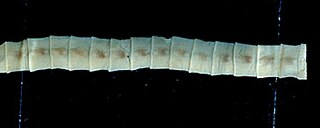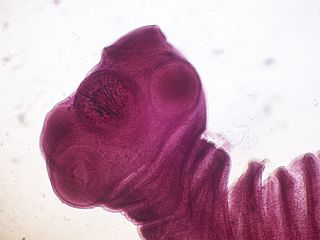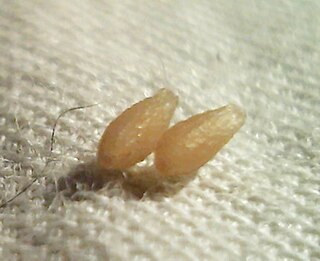
Diphyllobothrium is a genus of tapeworms which can cause diphyllobothriasis in humans through consumption of raw or undercooked fish. The principal species causing diphyllobothriasis is D. latum, known as the broad or fish tapeworm, or broad fish tapeworm. D. latum is a pseudophyllid cestode that infects fish and mammals. D. latum is native to Scandinavia, western Russia, and the Baltics, though it is now also present in North America, especially the Pacific Northwest. In Far East Russia, D. klebanovskii, having Pacific salmon as its second intermediate host, was identified.
Hymenolepiasis is infestation by one of two species of tapeworm: Hymenolepis nana or H. diminuta. Alternative names are dwarf tapeworm infection and rat tapeworm infection. The disease is a type of helminthiasis which is classified as a neglected tropical disease.

Taenia solium, the pork tapeworm, belongs to the cyclophyllid cestode family Taeniidae. It is found throughout the world and is most common in countries where pork is eaten. It is a tapeworm which has humans as its definitive host and often pigs as intermediate or secondary host. It may be transmitted to pigs through human faeces contaminating their fodder, and back to humans through consumption of uncooked, or under-cooked, pork that contains tapeworm cysts. Pigs ingest tapeworm eggs, which develop into larvae, then into oncospheres, and ultimately into infective tapeworm cysts. An ingested tapeworm cyst grows into an adult worm in human small intestines.
Spirometra is a genus of pseudophyllid cestodes that reproduce in canines and felines, but can also cause pathology in humans if infected. As an adult, this tapeworm lives in the small intestine of its definitive host and produces eggs that pass with the animal's feces. When the eggs reach water, the eggs hatch into coracidia which are eaten by copepods. The copepods are eaten by a second intermediate host to continue the life cycle. Humans can become infected if they accidentally eat frog legs or fish with the plerocercoid stage encysted in the muscle. In humans, an infection of Spirometra is termed sparganosis.

Taenia is a genus of tapeworms that includes some important parasites of livestock. Members of the genus are responsible for taeniasis and cysticercosis in humans, which are a type of helminthiasis belonging to the group of neglected tropical diseases. More than 100 species are recorded. They are morphologically characterized by a ribbon-like body composed of a series of segments called proglottids; hence the name Taenia. The anterior end of the body is the scolex. Not all members of the genus Taenia have an armed scolex, for example, Taenia saginata has an unarmed scolex, while Taenia solium has an armed scolex.

Echinococcus granulosus, also called the hydatid worm, hyper tape-worm or dog tapeworm, is a cyclophyllid cestode that dwells in the small intestine of canids as an adult, but which has important intermediate hosts such as livestock and humans, where it causes cystic echinococcosis, also known as hydatid disease. The adult tapeworm ranges in length from 3 mm to 6 mm and has three proglottids ("segments") when intact—an immature proglottid, mature proglottid and a gravid proglottid. The average number of eggs per gravid proglottid is 823. Like all cyclophyllideans, E. granulosus has four suckers on its scolex ("head"), and E. granulosus also has a rostellum with hooks. Several strains of E. granulosus have been identified, and all but two are noted to be infective in humans.

Echinococcus multilocularis is a small cyclophyllid tapeworm found extensively in the northern hemisphere. E. multilocularis, along with other members of the Echinococcus genus, produce diseases known as echinococcosis. Unlike E. granulosus,E. multilocularis produces many small cysts that spread throughout the internal organs of the infected animal. The resultant disease is called Alveolar echinococcosis, and is caused by ingesting the eggs of E. multilocularis.

Dipylidium caninum, also called the flea tapeworm, double-pored tapeworm, or cucumber tapeworm, is a cyclophyllid cestode that infects organisms afflicted with fleas and canine chewing lice, including dogs, cats, and sometimes human pet-owners, especially children.

Dwarf tapeworm is a cosmopolitan species though most common in temperate zones, and is one of the most common cestodes infecting humans, especially children.

Taenia crassiceps is a tapeworm in the family Taeniidae. It is a parasitic organism whose adult form infects the intestine of carnivores, like canids. It is related to Taenia solium, the pork tapeworm, and to Taenia saginata, the beef tapeworm. It is commonly found in the Northern Hemisphere, especially throughout Canada and the northern United States.

Taenia pisiformis, commonly called the rabbit tapeworm, is an endoparasitic tapeworm which causes infection in lagomorphs, rodents, and carnivores. Adult T. pisiformis typically occur within the small intestines of the definitive hosts, the carnivores. Lagomorphs, the intermediate hosts, are infected by fecal contamination of grasses and other food sources by the definitive hosts. The larval stage is often referred to as Cysticercus pisiformis and is found on the livers and peritoneal cavities of the intermediate hosts. T. pisiformis can be found worldwide.

Eucestoda, commonly referred to as tapeworms, are the larger of the two subclasses of flatworms in the class Cestoda. Larvae have six posterior hooks on the scolex (head), in contrast to the ten-hooked Cestodaria. All tapeworms are endoparasites of vertebrates, living in the digestive tract or related ducts. Examples are the pork tapeworm with a human definitive host, and pigs as the secondary host, and Moniezia expansa, the definitive hosts of which are ruminants.
Spirometra erinaceieuropaei is a parasitic tapeworm that infects domestic animals and humans. The medical term for this infection in humans and other animals is sparganosis. Morphologically, these worms are similar to other worms in the genus Spirometra. They have a long body consisting of three sections: the scolex, the neck, and the strobilia. They have a complex life cycle that consists of three hosts, and can live in varying environments and bodily tissues. Humans can contract this parasite in three main ways. Historically, humans are considered a paratenic host; however, the first case of an adult S. erinaceieuropaei infection in humans was reported in 2017. Spirometra tapeworms exist worldwide and infection is common in animals, but S. erinaceieuropaei infections are rare in humans. Treatment for infection typically includes surgical removal and anti-worm medication.
Sparganosis is a parasitic infection caused by the plerocercoid larvae of the genus Spirometra including S. mansoni, S. ranarum, S. mansonoides and S. erinacei. It was first described by Patrick Manson from China in 1882, and the first human case was reported by Charles Wardell Stiles from Florida in 1908. The infection is transmitted by ingestion of contaminated water, ingestion of a second intermediate host such as a frog or snake, or contact between a second intermediate host and an open wound or mucous membrane. Humans are the accidental hosts in the life cycle, while dogs, cats, and other mammals are definitive hosts. Copepods are the first intermediate hosts, and various amphibians and reptiles are second intermediate hosts.
Diphyllobothriasis is the infection caused by tapeworms of the genus Diphyllobothrium.
Diphyllobothrium mansonoides is a species of tapeworm (cestodes) that is endemic to North America. Infection with D. mansonoides in humans can result in sparganosis. Justus F. Mueller first reported this organism in 1935. D. mansonoides is similar to D. latum and Spirometra erinacei. When the organism was discovered, scientist did not know if D. mansonoides and S. erinacei were separate species. PCR analysis of the two worms has shown the two to be separate but closely related organisms.

Taenia taeniaeformis is a parasitic tapeworm, with cats as the primary definitive hosts. Sometime dogs can also be the definitive host. The intermediate hosts are rodents and less frequently lagomorphs (rabbits). The definitive host must ingest the liver of the intermediate host in order to acquire infection. The worm tends to be white, thick bodied, and around 15 to 60 cm in length. This species of tape worm is much less frequently encountered than Dipylidium caninum, which has fleas as its intermediate host rather than rodents but exhibits most of the same physical characteristics and is treated with the same medications.

Coenurosis is a parasitic infection that results when humans ingest the eggs of dog tapeworm species Taenia multiceps, T. serialis, T. brauni, or T. glomerata.

Coenurosis, also known as caenurosis, coenuriasis, gid or sturdy, is a parasitic infection that develops in the intermediate hosts of some tapeworm species. It is caused by the coenurus, the larval stage of these tapeworms. The disease occurs mainly in sheep and other ungulates, but it can also occur in humans by accidental ingestion of tapeworm eggs.

Taenia hydatigena is one of the adult forms of the canine and feline tapeworm. This infection has a worldwide geographic distribution. Humans with taeniasis can infect other humans or animal intermediate hosts by eggs and gravid proglottids passed in the feces.









